As we approach 2026, the tech world is on the brink of exciting changes, with technology becoming an even bigger part of our day-to-day lives. We now rely on smart devices for the simplest tasks more than ever before.
Back in 2020, tech giants like Google, Amazon, Apple, Microsoft, and Meta acquired around 13 AI startups, signaling a major shift in the software industry.
From ChatGPT to autonomous vehicles, AI continues to be one of the most exciting—and controversial—technology trends shaping the 21st century.
But just how big is the AI space? How fast is it growing?
In this article, we dive into the top Artificial Intelligence stats that show why AI is one of the fastest-growing markets as we head into 2026, and how businesses are leveraging this powerful technology to stay ahead and boost their profits.
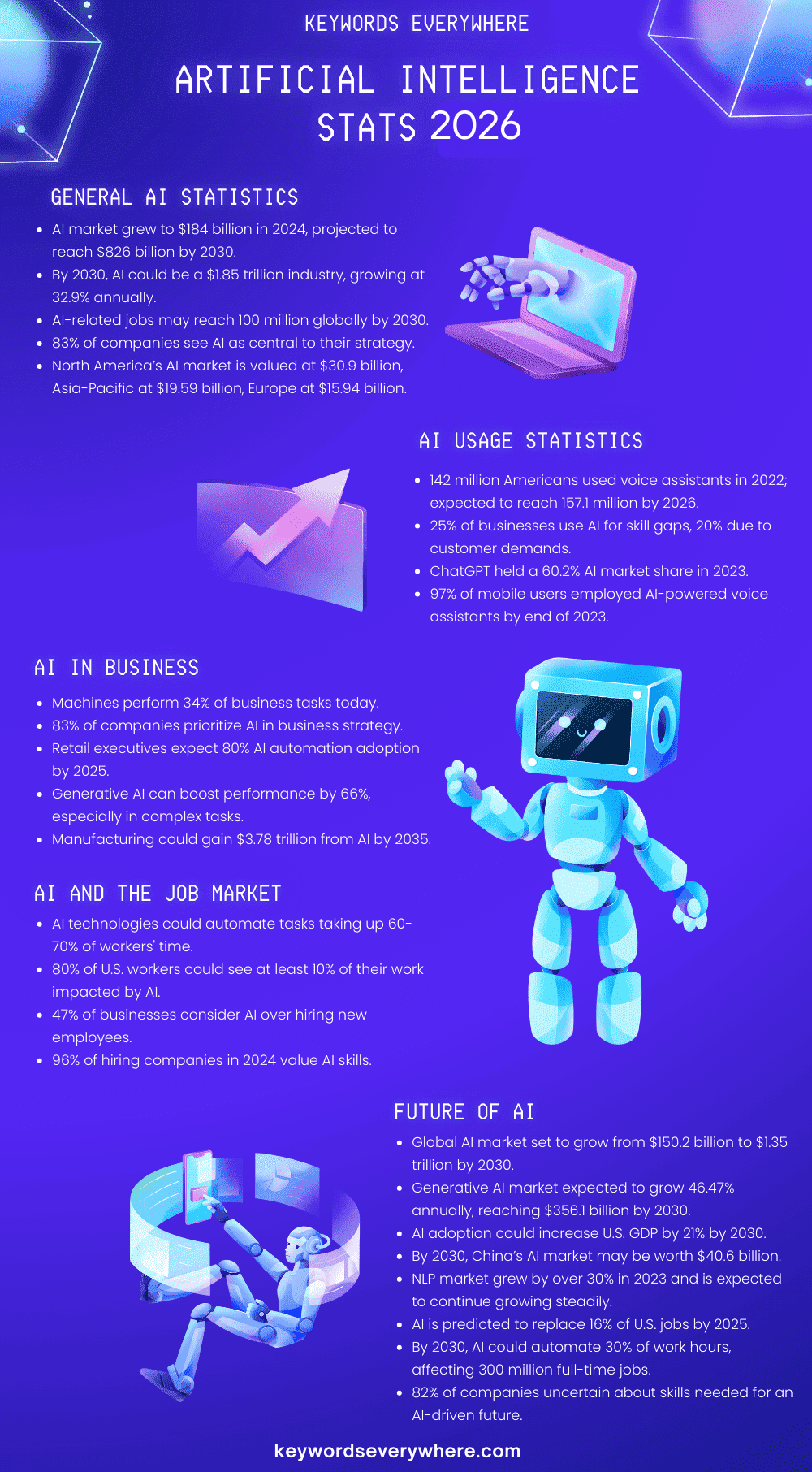
General Artificial Intelligence Statistics
Artificial Intelligence is no longer just a concept of the future—it’s a reality that’s already deeply woven into our everyday devices and systems.
Below are some general AI statistics that shed light on the key aspects of this groundbreaking technology:
1. The AI market saw impressive growth in 2024, reaching over $184 billion—a jump of nearly $50 billion from 2023. And this is just the beginning. The market is expected to soar past $826 billion by 2030.
2. By 2030, AI is projected to hit a whopping $1.85 trillion, with an annual growth rate of 32.9% between 2022 and 2030.

Source
3. AI could partially automate about two-thirds of jobs, but many of these roles won’t disappear—they’ll be enhanced by AI instead of replaced.
4. Over 80% of companies have already started using AI in some way, and for 83% of them, AI is at the heart of their business strategy.
5. Looking ahead to 2025, 80% of companies plan to embrace intelligent automation, a powerful combination of AI and automation.
6. In China, around 58% of companies are already using AI, with another 30% exploring it. India ranks second in AI adoption, while the global average stands at 34% of companies using AI and 42% considering it.
7. As of 2023, the North American AI market was valued at $30.9 billion. Asia-Pacific follows with $19.59 billion, and Europe with $15.94 billion.

Source
8. With AI growing rapidly, the World Economic Forum predicts there will be 100 million AI-related jobs globally by 2030, and businesses will need 97 million people to meet their expanding AI needs.
9. Worldwide, spending on AI-focused systems hit $154 billion in 2023, with the banking sector leading the charge at $20.6 billion.
10. ChatGPT, launched in November 2022, broke records by gaining over a million users in just five days and 100 million users within two months, making it the fastest-growing consumer app at the time—until Facebook’s Threads app came along.
11. According to Keywords Everywhere, all “Artificial Intelligence” terms have sky-high search volumes, showing that more and more people are turning to AI for personal and professional tasks.
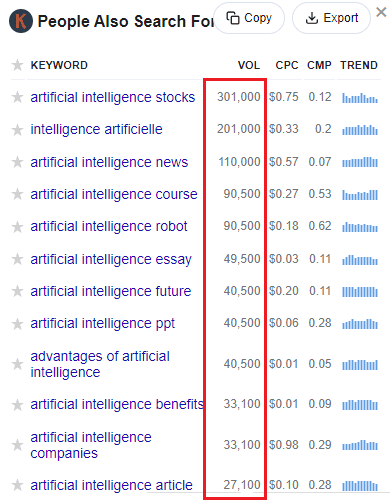
AI Usage Statistics
How many people are using AI, and what are the most common ways that individuals and businesses are leveraging this evolving technology?
Let’s dive into some statistics that show just how widespread AI has become in 2025.
12. In 2022, around 142 million people in the U.S. used voice assistants, which is nearly half the country’s population. By 2026, that number is expected to grow to 157.1 million users.
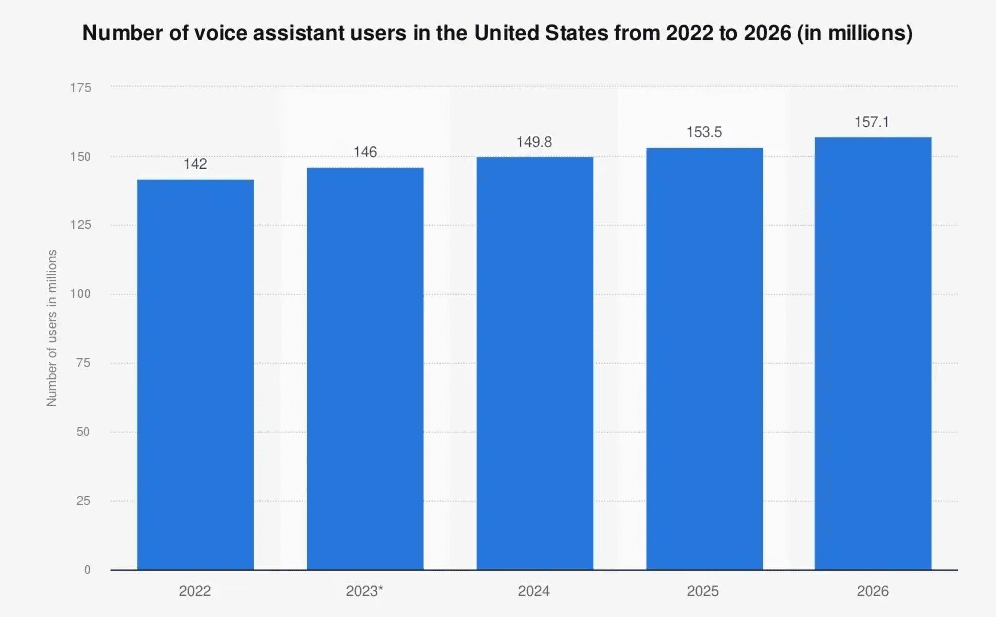
Source
13. About 25% of businesses use AI to help fill skill gaps, while around 20% turn to AI due to pressures from customer demands or competition.
14. In 2023, ChatGPT dominated the AI market with a 60.2% share, far ahead of the second-place tool, Character.AI, which had about 16%.
15. Some smartwatches now use AI to help time hand-washing sessions for better hygiene. Wearable tech is also supporting the healthcare industry in its quest for better health outcomes.
16. AI plays a role in disease prevention by detecting new strains. For example, before COVID-19 became widely known, AI had already flagged an outbreak of an unknown type of pneumonia.
17. By the end of 2023, 97% of mobile users were using AI-powered voice assistants, totaling 145.1 million users. Growth is expected to continue at around 3% per year until 2027.
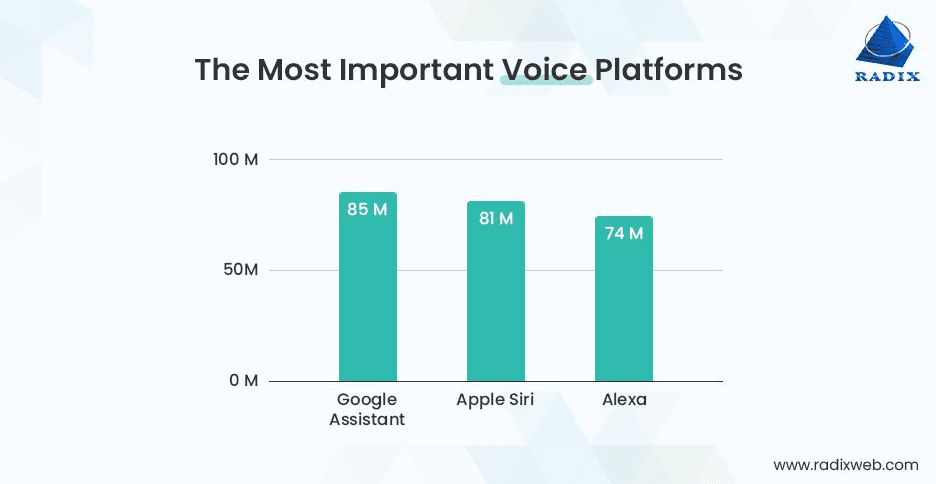
Source
18. According to a Salesforce survey, 23% of customer care organizations now use AI chatbots to improve support.
19. 85.1% of AI users employ the technology for writing articles and creating content. Meanwhile, 81.6% of digital marketers believe AI might put content writers’ jobs at risk.
AI Statistics for Business
Today’s AI tools are great at tracking what consumers do online, including their behavior and preferences. This helps companies market their products and services more effectively.
The growing use of AI in business shows just how powerful it can be.
Check out these artificial intelligence stats to see how companies are teaming up with AI to boost profits and drive growth.
20. Today, machines handle about 34% of all business tasks.
21. An impressive 83% of companies say that making AI a key part of their business strategy is a top priority. Common AI tools in business include automated emails and chatbots.
22. By 2025, 80% of retail executives expect their businesses to use AI automation. Most believe this will happen within the next three years.
23. Studies show that using generative AI (like ChatGPT) can boost performance by 66%, with even greater benefits for complex tasks and less-skilled workers.
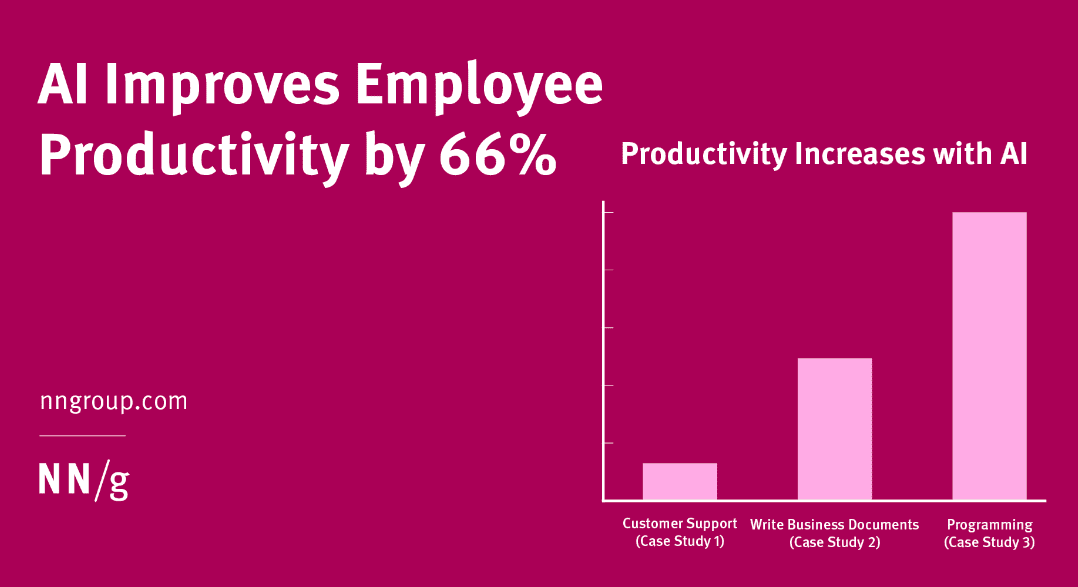
Source
24. To keep their data accurate, 48% of businesses rely on machine learning (ML), data analysis, and AI tools.
25. The manufacturing industry is projected to gain $3.78 trillion from AI by 2035.
26. In telecommunications, 52% of organizations use chatbots to improve productivity.
27. By August 2023, over 80% of Fortune 500 companies had adopted ChatGPT for their business needs.
28. In the U.S., 46% of companies have saved $25,000 and $70,000 by using one of the most popular tools—ChatGPT.
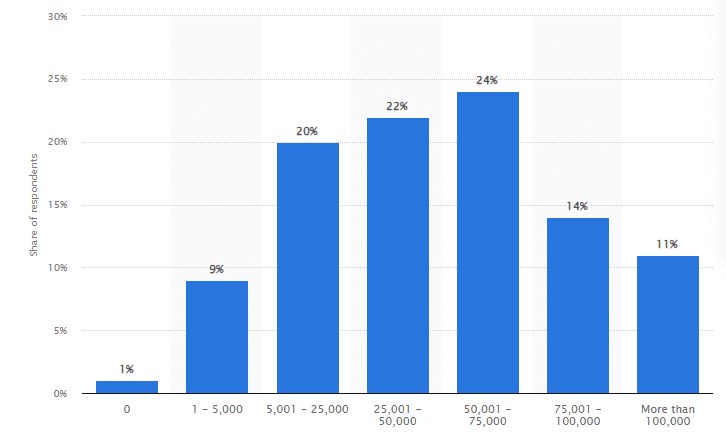
Source
29. In July 2023, a solid 79% of corporate strategists said that technologies like AI will be crucial to their success over the next two years.
30. Strategists believe that up to 50% of strategic planning and execution tasks could be automated, though currently, only 15% are.
AI Adoption Statistics and the Job Market
The AI revolution is changing not just how businesses run but also the job market. These AI stats show how job opportunities and challenges are shifting as AI continues to evolve.
31. Current AI technologies can automate tasks that take up 60% to 70% of workers’ time.
32. About 80% of workers in the U.S. might see at least 10% of their work affected by generative AI, with 19% of the workforce facing more than half of their tasks being impacted.
33. Data management jobs will be hit hardest by AI. Around 90% of data processing jobs and 80% of data collection jobs are likely to be automated due to generative AI.
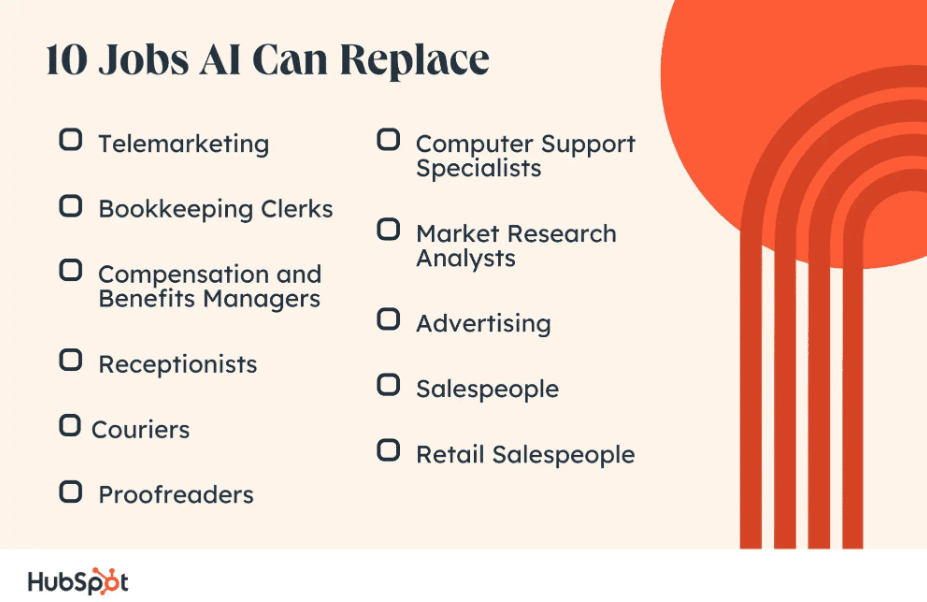
Source
34. According to 51% of workers, AI can help them achieve a better work-life balance. By speeding up tasks, AI gives workers more time to spend with friends and family.
35. Around 43% of employees use AI to understand data and trends to make better decisions, while 41% use it to transfer and share data.
36. In the next few years, AI and machine learning (ML) are expected to replace 16% of U.S. jobs. However, new jobs will be created by the AI market, resulting in a net loss of 7% of jobs.
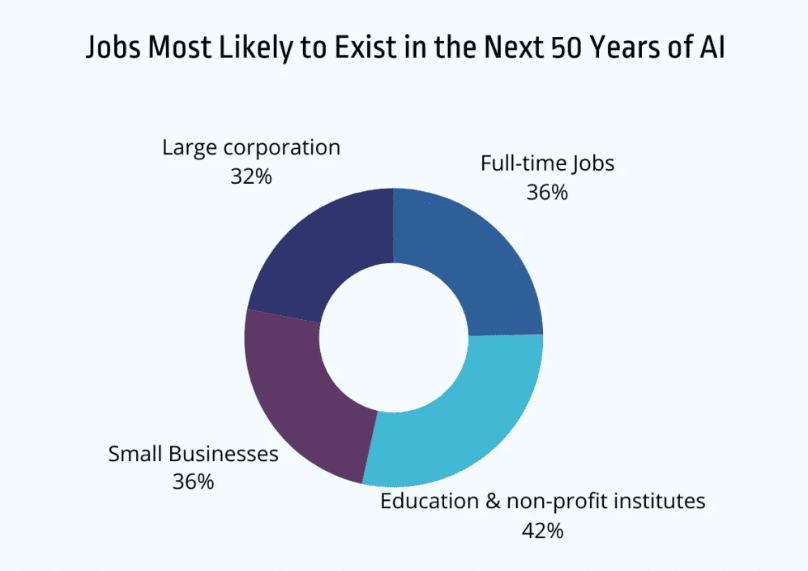
Source
37. Fifty-two percent of employed U.S. adults are worried that AI might take their jobs.
38. Forty-seven percent of businesses are considering using AI instead of hiring new employees.
39. Ninety-six percent of companies hiring in 2024 say that candidates with AI skills will have an edge.
40. Many people are concerned that AI will continue to replace human workers, leading to a job crisis, especially in the transportation and storage sectors, which are at the highest risk of automation.
AI Marketing Statistics
Marketers are quickly jumping on the AI bandwagon. Most of them feel sure about learning and using this technology.
Check out these key artificial intelligence stats that show how marketers are using AI tools to grab their audience’s attention and boost their marketing efforts:
41. In a 2023 survey of U.S. advertising and marketing professionals, it was found that 37% have used AI to help with their work.
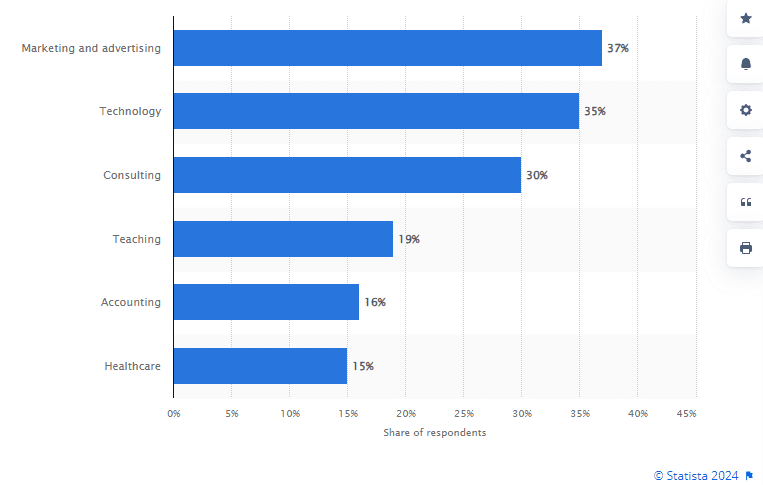
Source
42. 67% of marketers think that using marketing automation more is crucial for gaining and keeping customers.
43. 88% believe they need to use more automation and AI to meet customer needs and stay ahead of the competition.
44. Nearly 20% of marketing pros have allocated over 40% of their budget to AI-driven campaigns.
45. 87% of those using AI are applying it—or at least thinking about using it—for email marketing and sales forecasts.
46. 41% of marketers agree that AI helps boost revenue from email marketing.
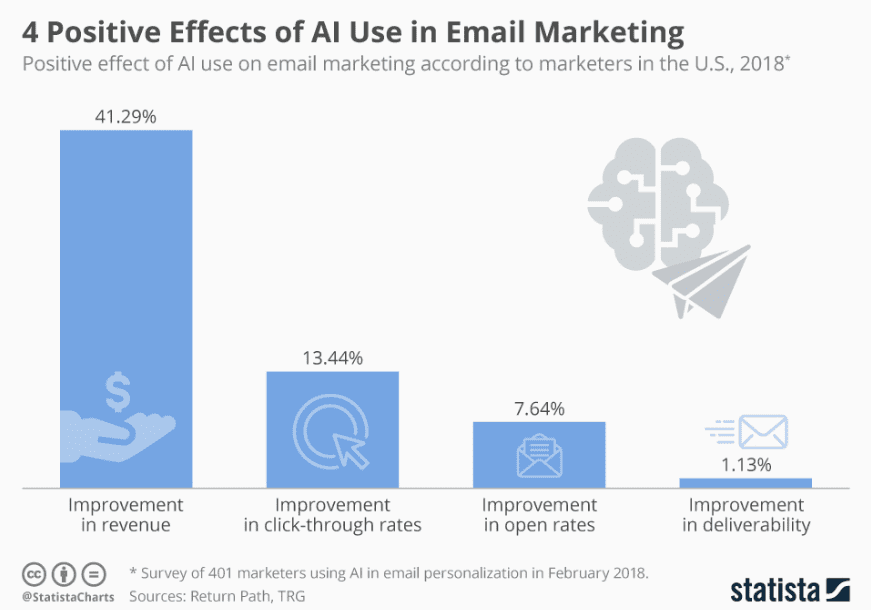
Source
47. 47% of advanced businesses have added AI to their mobile apps for marketing, and 84% use personalized approaches.
48. AI has seen the highest adoption and investment in software development, marketing, and customer service.
AI Growth Statistics
The rapid rise in AI use, mostly thanks to ChatGPT, has boosted excitement about AI’s future. Companies are pouring more money into AI across fields like healthcare, security, and education.
Here are some artificial intelligence stats that reveal how fast AI is growing and what we can expect in the future:
49. The global AI market is set to soar from $150.2 billion to $1,345.2 billion by 2030, growing at a rate of 36.8% each year. AI’s impact across different industries is massive and undeniable.
50. The Generative AI market is predicted to hit $36.06 billion in 2024 and grow annually by 46.47%, reaching $356.10 billion by 2030. The U.S. is expected to lead, with a market size of $11.66 billion in 2024.
51. AI adoption by companies worldwide is expected to grow by 36.6% per year from 2024 to 2030. By 2030, AI could boost the U.S. GDP by 21%.
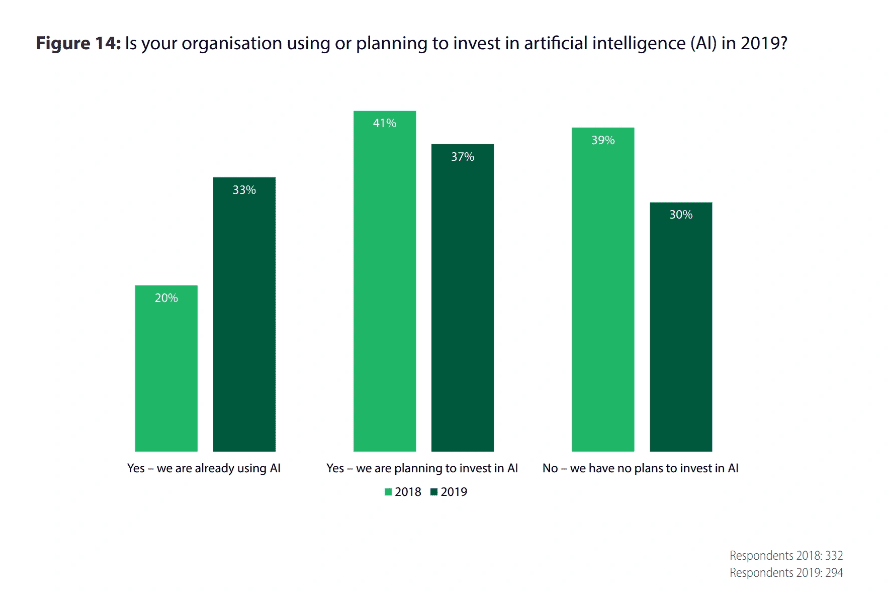
Source
52. From 2015 to 2019, the number of companies using AI services jumped by 270%. In 2015, only 10% of businesses were using or planning to use AI; by 2019, that number rose to 37%.
53. AI services generated about $19.4 billion in revenue in 2020 and grew to $62.5 billion by 2022. By 2025, the AI market is expected to reach $126 billion in annual revenue.
54. AI could generate a staggering $15.7 trillion in revenue by 2030, potentially boosting local economies’ GDP by 26%.
55. Almost 100 million people will be working in AI by next year. By 2025, around 97 million workers will be needed to meet the industry’s growing demands.
56. China, world’s second-largest economy, is expected to have an AI industry worth $40.6 billion by 2026, growing at 39.1% annually. By 2030, China could hold 26.1% of the global AI market.
57. The AI market in social media is projected to grow to $12 billion by 2031, with a growth rate of 28.7% from 2022 to 2031.
User Trust, AI Ethics, and Risk Management
Trust is crucial for people to widely accept and use AI. Here are some important stats about user trust, AI ethics, and managing risks:
58. Only 39% of U.S. adults think current AI technology is safe and secure.
59. 85% support a joint effort between the government, industry, and academia to make AI safer.
60. 80% of U.S. adults worry about artificial intelligence being used for cyber attacks, and 78% are concerned about AI being used for identity theft.
61. Despite these concerns, 65% of consumers still trust businesses that use AI. A Forbes survey shows that 33% are very likely to trust a business using AI, while 32% are somewhat likely.

Source
62. Even though chatbots are becoming more common, only 7% of people trust them when making a claim, compared to 49% who trust human advisors.
63. A Pew Research study shows that people are still wary of AI’s impact on American life. Only 15% say they are more excited than worried about AI becoming a bigger part of daily life. Meanwhile, 38% are more concerned than excited, and 46% feel a mix of both.
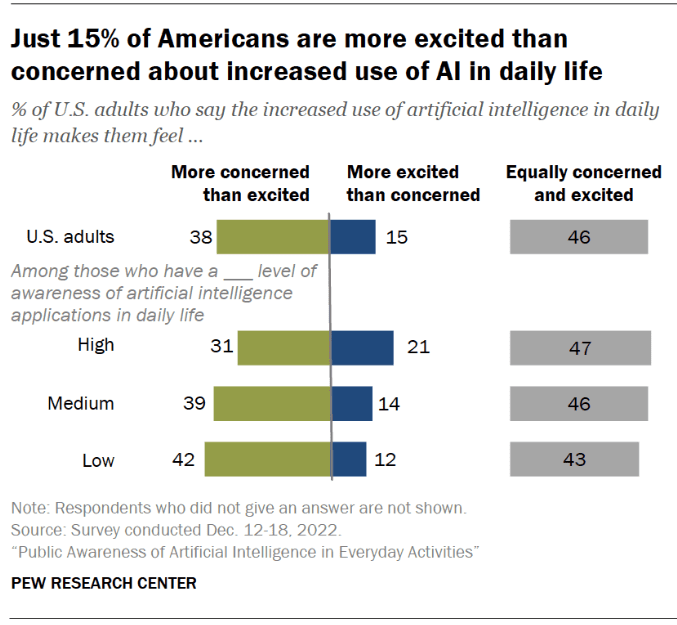
Source
64. 56% of companies see “inaccuracy” as the biggest risk of using generative AI, but only 32% have systems to manage these inaccuracies.
65. Nearly 75% of corporate executives saw AI ethics as important in 2021, up from less than 50% in 2018. However, 56% of executives aren’t sure if their companies have ethical guidelines for AI use.
66. An IBM study found that 74% of organizations using AI haven’t taken steps to reduce bias in their systems, and 60% haven’t developed policies for ethical AI use in the workplace.
67. A Stanford University report highlighted the risk of gender and racial bias in AI. For example, images generated with DALL-E 2 showed 97% of people in leadership roles as white men, even though women occupy 29.1% of CEO roles and 39.6% of director roles.
68. Pew Research survey found that 60% of U.S. adults would feel uneasy if their healthcare provider used AI for tasks like diagnosing diseases or recommending treatments. A smaller group, 39%, said they would feel comfortable with it.

Source
Overview of Leading AI Technologies
Since the launch of ChatGPT in November 2022, 2023 has been a game-changer for artificial intelligence. The past year has seen major strides, from a growing open-source community to advanced multimodal models, setting the stage for big breakthroughs in AI.
Here are some important artificial intelligence stats that provide an overview of the leading AI technologies:
69. Generative AI could add $2.6 trillion and $4.4 trillion in value to the global economy every year.
70. OpenAI, the creator of ChatGPT and DALL-E, is one of the most well-funded AI startups, with over $12 billion in investments as of 2023.
71. The natural language processing (NLP) market grew by over 30% globally in 2023, recovering from a nearly 29% drop in 2022. It is expected to keep growing at a steady rate of 10% to 15% annually through 2030.
72. Keywords Everywhere reports high search volumes for popular AI technologies on Google, showing their strong demand and popularity among users.
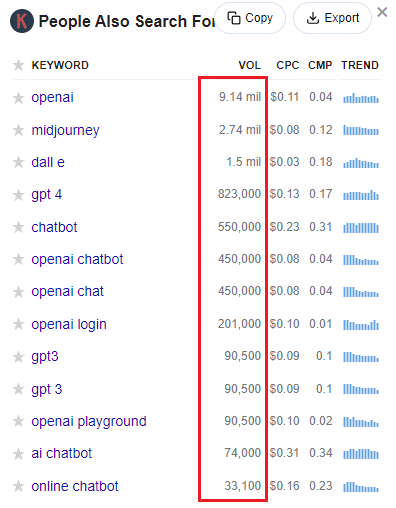
73. Netflix’s recommendation system, powered by AI, generates $1 billion in revenue each year. Many tech companies that invest in AI see significant revenue boosts as their algorithms keep users coming back for more.
74. Google’s deep machine learning technology is reported to be 99% accurate and has outperformed human pathologists in detecting metastatic breast cancer.
75. AI and machine learning (ML) are expected to replace 16% of U.S. jobs by 2025.
76. While 90% of leading companies invest in AI, only 14.6% have actually integrated AI into their operations.
77. 40% of executives believe that advanced AI technologies and the experts needed to run them are currently too expensive to implement.
78. According to Keywords Everywhere, interest in ChatGPT has stayed high over the last 12 months, suggesting users will likely continue using it for both personal and professional tasks.
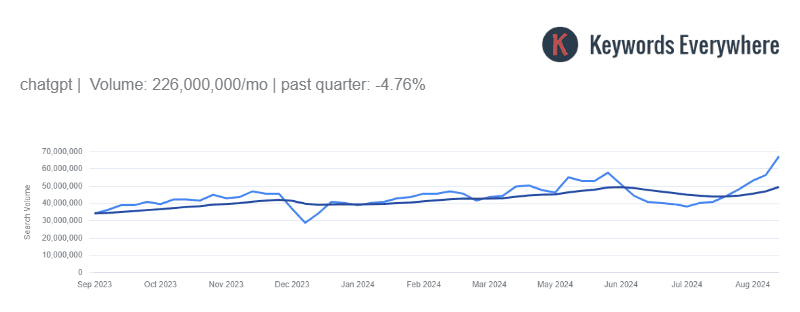
The Future of AI
Artificial intelligence is quickly changing the business world, and 2026 is set to bring even more advancements—and challenges.
Getting ready for an AI-driven future will help your team make smarter choices, engage more effectively with customers, and handle ethical issues.
Here are some important AI predictions and challenges to be aware of:
79. The generative AI market extent is expected to grow at an annual rate of 24.4% from 2023 to 2030, reaching $207 billion by 2030. This technology might also boost labor productivity by 0.1% to 0.6% each year until 2040.
80. A 2017 survey revealed that 76% of CEOs are concerned about AI’s lack of transparency and the risk of biased outcomes.
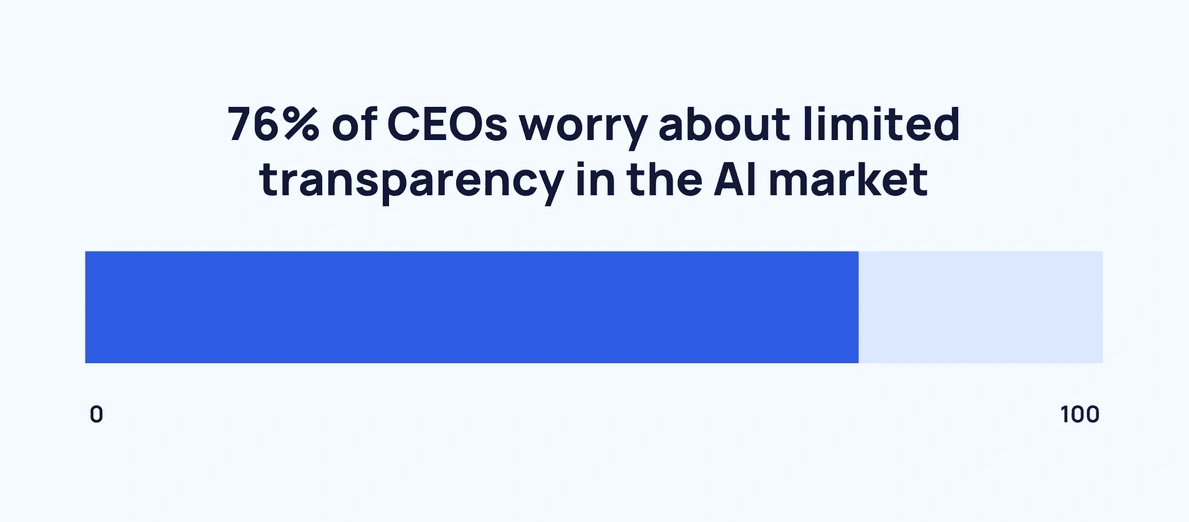
Source
81. By 2030, generative AI could automate 30% of the work hours people do today, potentially affecting 300 million full-time jobs.
82. Job loss is a major worry for those skeptical of AI. As AI advances, there are ethical, business, and practical concerns to address.
83. Upskilling for AI’s future is crucial, but 82% of employers and employees aren’t sure which skills to focus on, and 80% don’t know about available external training options.
Conclusion
These artificial intelligence stats make it clear: AI is now a major part of our world.
Most businesses and consumers are already using it in some way. And with AI expected to grow even faster over the next decade, its use will continue to expand.
But this rapid growth comes with challenges, like its impact on jobs, overreliance on technology, and security concerns.
Despite these issues, the widespread use of AI means that solutions will be found and implemented.


